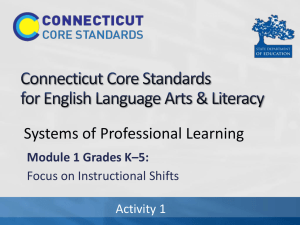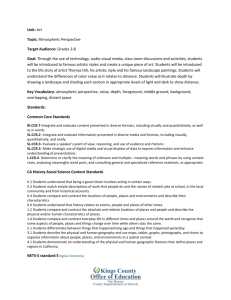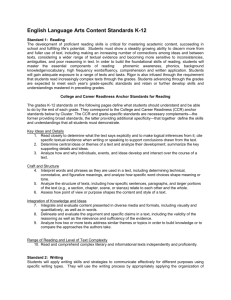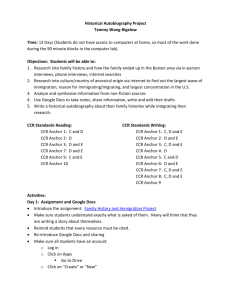Third Grade Curriculum Guide
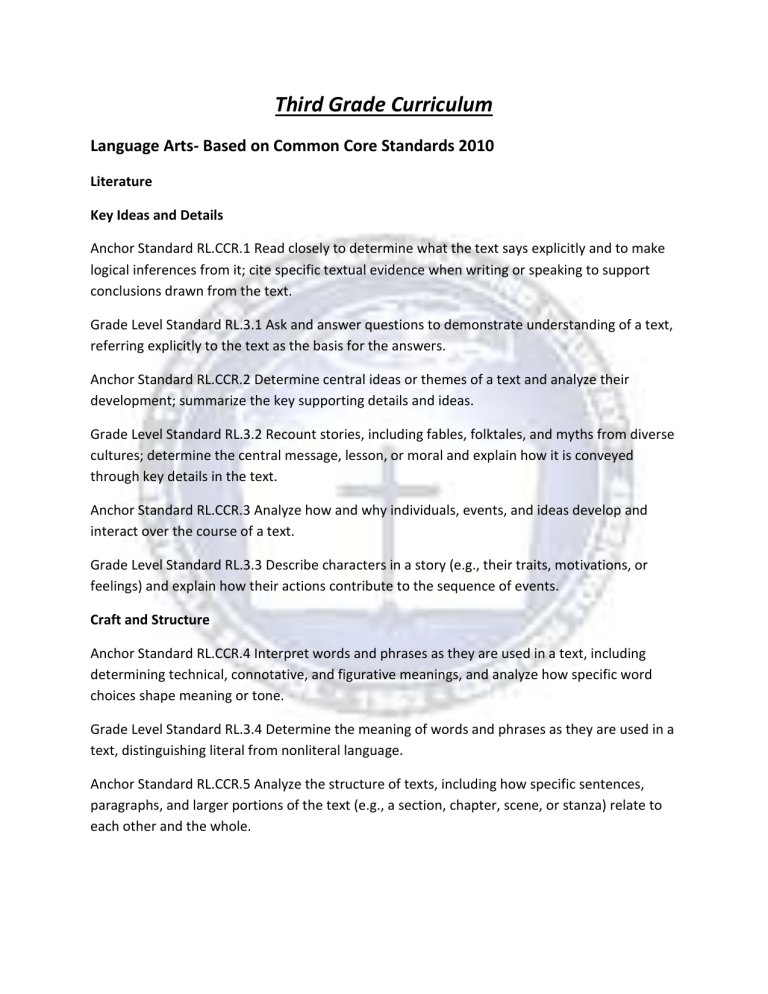
Third Grade Curriculum
Language Arts- Based on Common Core Standards 2010
Literature
Key Ideas and Details
Anchor Standard RL.CCR.1 Read closely to determine what the text says explicitly and to make logical inferences from it; cite specific textual evidence when writing or speaking to support conclusions drawn from the text.
Grade Level Standard RL.3.1 Ask and answer questions to demonstrate understanding of a text, referring explicitly to the text as the basis for the answers.
Anchor Standard RL.CCR.2 Determine central ideas or themes of a text and analyze their development; summarize the key supporting details and ideas.
Grade Level Standard RL.3.2 Recount stories, including fables, folktales, and myths from diverse cultures; determine the central message, lesson, or moral and explain how it is conveyed through key details in the text.
Anchor Standard RL.CCR.3 Analyze how and why individuals, events, and ideas develop and interact over the course of a text.
Grade Level Standard RL.3.3 Describe characters in a story (e.g., their traits, motivations, or feelings) and explain how their actions contribute to the sequence of events.
Craft and Structure
Anchor Standard RL.CCR.4 Interpret words and phrases as they are used in a text, including determining technical, connotative, and figurative meanings, and analyze how specific word choices shape meaning or tone.
Grade Level Standard RL.3.4 Determine the meaning of words and phrases as they are used in a text, distinguishing literal from nonliteral language.
Anchor Standard RL.CCR.5 Analyze the structure of texts, including how specific sentences, paragraphs, and larger portions of the text (e.g., a section, chapter, scene, or stanza) relate to each other and the whole.
Grade Level Standard RL.3.5 Refer to parts of stories, dramas, and poems when writing or speaking about a text, using terms such as chapter, scene, and stanza; describe how each successive part builds on earlier sections.
Anchor Standard RL.CCR.6 Assess how point of view or purpose shapes the content and style of a text.
Grade Level Standard RL.3.6 Distinguish their own point of view from that of the narrator or those of the characters.
Integration of Knowledge and Ideas
Anchor Standard RL.CCR.7 Integrate and evaluate content presented in diverse media and formats, including visually and quantitatively, as well as in words.
Grade Level Standard RL.3.7 Explain how specific aspects of a text’s illustrations contribute to what is conveyed by the words in a story (e.g., create mood, emphasize aspects of a character or setting).
Anchor Standard RL.CCR.8 Delineate and evaluate the argument and specific claims in a text, including the validity of the reasoning as well as the relevance and sufficiency of the evidence.
Anchor Standard RL.CCR.9 Analyze how two or more texts address similar themes or topics in order to build knowledge or to compare the approaches the authors take.
Grade Level Standard RL.3.9 Compare and contrast the themes, settings, and plots of stories written by the same author about the same or similar characters (e.g., in books from a series).
Range of Reading and Level of Text Complexity
Anchor Standard RL.CCR.10 Read and comprehend complex literary and informational texts independently and proficiently.
Grade Level Standard RL.3.10 By the end of the year, read and comprehend literature, including stories, dramas, and poetry, at the high end of the grades 2–3 text complexity band independently and proficiently.
RI Informational Text
Key Ideas and Details
Anchor Standard RI.CCR.1 Read closely to determine what the text says explicitly and to make logical inferences from it; cite specific textual evidence when writing or speaking to support conclusions drawn from the text.
Grade Level Standard RI.3.1 Ask and answer questions to demonstrate understanding of a text, referring explicitly to the text as the basis for the answers.
Anchor Standard RI.CCR.2 Determine central ideas or themes of a text and analyze their development; summarize the key supporting details and ideas.
Grade Level Standard RI.3.2 Determine the main idea of a text; recount the key details and explain how they support the main idea.
Anchor Standard RI.CCR.3 Analyze how and why individuals, events, and ideas develop and interact over the course of a text.
Grade Level Standard RI.3.3 Describe the relationship between a series of historical events, scientific ideas or concepts, or steps in technical procedures in a text, using language that pertains to time, sequence, and cause/effect.
Craft and Structure
Anchor Standard RI.CCR.4 Interpret words and phrases as they are used in a text, including determining technical, connotative, and figurative meanings, and analyze how specific word choices shape meaning or tone.
Grade Level Standard RI.3.4 Determine the meaning of general academic and domain-specific words and phrases in a text relevant to a grade 3 topic or subject area.
Anchor Standard RI.CCR.5 Analyze the structure of texts, including how specific sentences, paragraphs, and larger portions of the text (e.g., a section, chapter, scene, or stanza) relate to each other and the whole.
Grade Level Standard RI.3.5 Use text features and search tools (e.g., key words, sidebars, hyperlinks) to locate information relevant to a given topic efficiently.
Anchor Standard RI.CCR.6 Assess how point of view or purpose shapes the content and style of a text.
Grade Level Standard RI.3.6 Distinguish their own point of view from that of the author of a text.
Integration of Knowledge and Ideas
Anchor Standard RI.CCR.7 Integrate and evaluate content presented in diverse media and formats, including visually and quantitatively, as well as in words.
Grade Level Standard RI.3.7 Use information gained from illustrations (e.g., maps, photographs) and the words in a text to demonstrate understanding of the text (e.g., where, when, why, and how key events occur).
Anchor Standard RI.CCR.8 Delineate and evaluate the argument and specific claims in a text, including the validity of the reasoning as well as the relevance and sufficiency of the evidence.
Grade Level Standard RI.3.8 Describe the logical connection between particular sentences and paragraphs in a text (e.g., comparison, cause/effect, first/second/third in a sequence).
Anchor Standard RI.CCR.9 Analyze how two or more texts address similar themes or topics in order to build knowledge or to compare the approaches the authors take.
Grade Level Standard RI.3.9 Compare and contrast the most important points and key details presented in two texts on the same topic.
Range of Reading and Level of Text Complexity
Anchor Standard RI.CCR.10 Read and comprehend complex literary and informational texts independently and proficiently.
Grade Level Standard RI.3.10 By the end of the year, read and comprehend informational texts, including history/social studies, science, and technical texts, at the high end of the grades 2–3 text complexity band independently and proficiently
.
RF Foundational Skills
Phonics and Word Recognition
Grade Level Standard RF.3.3 Know and apply grade-level phonics and word analysis skills in decoding words.
RF.3.3.a Identify and know the meaning of the most common prefixes and derivational suffixes.
RF.3.3.b Decode words with common Latin suffixes.
RF.3.3.c Decode multisyllable words.
RF.3.3.d Read grade-appropriate irregularly spelled words.
Fluency
Grade Level Standard RF.3.4 Read with sufficient accuracy and fluency to support comprehension.
RF.3.4.a Read on-level text with purpose and understanding.
RF.3.4.b Read on-level prose and poetry orally with accuracy, appropriate rate, and expression on successive readings.
RF.3.4.c Use context to confirm or self-correct word recognition and understanding, rereading as necessary.
Strand W Writing
Text Types and Purposes
Anchor Standard W.CCR.1 Write arguments to support claims in an analysis of substantive topics or texts, using valid reasoning and relevant and sufficient evidence.
Grade Level Standard W.3.1 Write opinion pieces on topics or texts, supporting a point of view with reasons.
W.3.1.a Introduce the topic or text they are writing about, state an opinion, and create an organizational structure that lists reasons.
W.3.1.b Provide reasons that support the opinion.
W.3.1.c Use linking words and phrases (e.g., because, therefore, since, for example) to connect opinion and reasons.
W.3.1.d Provide a concluding statement or section.
Anchor Standard W.CCR.2 Write informative/explanatory texts to examine and convey complex ideas and information clearly and accurately through the effective selection, organization, and analysis of content.
Grade Level Standard W.3.2 Write informative/explanatory texts to examine a topic and convey ideas and information clearly.
W.3.2.a Introduce a topic and group related information together; include illustrations when useful to aiding comprehension.
W.3.2.b Develop the topic with facts, definitions, and details.
W.3.2.c Use linking words and phrases (e.g., also, another, and, more, but) to connect ideas within categories of information.
W.3.2.d Provide a concluding statement or section.
Anchor Standard W.CCR.3 Write narratives to develop real or imagined experiences or events using effective technique, well-chosen details, and well-structured event sequences.
Grade Level Standard W.3.3 Write narratives to develop real or imagined experiences or events using effective technique, descriptive details, and clear event sequences.
W.3.3.a Establish a situation and introduce a narrator and/or characters; organize an event sequence that unfolds naturally.
W.3.3.b Use dialogue and descriptions of actions, thoughts, and feelings to develop experiences and events or show the response of characters to situations.
W.3.3.c Use temporal words and phrases to signal event order.
W.3.3.d Provide a sense of closure.
Production and Distribution of Writing
Anchor Standard W.CCR.4 Produce clear and coherent writing in which the development, organization, and style are appropriate to task, purpose, and audience.
Grade Level Standard W.3.4 With guidance and support from adults, produce writing in which the development and organization are appropriate to task and purpose.
Anchor Standard W.CCR.5 Develop and strengthen writing as needed by planning, revising, editing, rewriting, or trying a new approach.
Grade Level Standard W.3.5 With guidance and support from peers and adults, develop and strengthen writing as needed by planning, revising, and editing.
Anchor Standard W.CCR.6 Use technology, including the Internet, to produce and publish writing and to interact and collaborate with others.
Grade Level Standard W.3.6 With guidance and support from adults, use technology to produce and publish writing (using keyboarding skills) as well as to interact and collaborate with others.
Research to Build and Present Knowledge
Anchor Standard W.CCR.7 Conduct short as well as more sustained research projects based on focused questions, demonstrating understanding of the subject under investigation.
Grade Level Standard W.3.7 Conduct short research projects that build knowledge about a topic.
Anchor Standard W.CCR.8 Gather relevant information from multiple print and digital sources, assess the credibility and accuracy of each source, and integrate the information while avoiding plagiarism.
Grade Level Standard W.3.8 Recall information from experiences or gather information from print and digital sources; take brief notes on sources and sort evidence into provided categories.
Anchor Standard W.CCR.9 Draw evidence from literary or informational texts to support analysis, reflection, and research.
Grade Level Standard W.3.9 (Begins in grade 4)
Range of Writing
Anchor Standard W.CCR.10 Write routinely over extended time frames (time for research, reflection, and revision) and shorter time frames (a single sitting or a day or two) for a range of tasks, purposes, and audiences.
Grade Level Standard W.3.10 Write routinely over extended time frames (time for research, reflection, and revision) and shorter time frames (a single sitting or a day or two) for a range of discipline-specific tasks, purposes, and audiences.
Strand SL Speaking and Listening
Comprehension and Collaboration
Anchor Standard SL.CCR.1 Prepare for and participate effectively in a range of conversations and collaborations with diverse partners, building on others’ ideas and expressing their own clearly and persuasively.
Grade Level Standard SL.3.1 Engage effectively in a range of collaborative discussions (one-onone, in groups, and teacher-led) with diverse partners on grade 3 topics and texts, building on others’ ideas and expressing their own clearly.
SL.3.1.a Come to discussions prepared, having read or studied required material; explicitly draw on that preparation and other information known about the topic to explore ideas under discussion.
SL.3.1.b Follow agreed-upon rules for discussions (e.g., gaining the floor in respectful ways, listening to others with care, speaking one at a time about the topics and texts under discussion).
SL.3.1.c Ask questions to check understanding of information presented, stay on topic, and link their comments to the remarks of others.
SL.3.1.d Explain their own ideas and understanding in light of the discussion.
Anchor Standard SL.CCR.2 Integrate and evaluate information presented in diverse media and formats, including visually, quantitatively, and orally.
Grade Level Standard SL.3.2 Determine the main ideas and supporting details of a text read aloud or information presented in diverse media and formats, including visually, quantitatively, and orally.
Anchor Standard SL.CCR.3 Evaluate a speaker’s point of view, reasoning, and use of evidence and rhetoric.
Grade Level Standard SL.3.3 Ask and answer questions about information from a speaker, offering appropriate elaboration and detail.
Presentation of Knowledge and Ideas
Anchor Standard SL.CCR.4 Present information, findings, and supporting evidence such that listeners can follow the line of reasoning and the organization, development, and style are appropriate to task, purpose, and audience.
Grade Level Standard SL.3.4 Report on a topic or text, tell a story, or recount an experience with appropriate facts and relevant, descriptive details, speaking clearly at an understandable pace.
Anchor Standard SL.CCR.5 Make strategic use of digital media and visual displays of data to express information and enhance understanding of presentations.
Grade Level Standard SL.3.5 Create engaging audio recordings of stories or poems that demonstrate fluid reading at an understandable pace; add visual displays when appropriate to emphasize or enhance certain facts or details.
Anchor Standard SL.CCR.6 Adapt speech to a variety of contexts and communicative tasks, demonstrating command of formal English when indicated or appropriate.
Grade Level Standard SL.3.6 Speak in complete sentences when appropriate to task and situation in order to provide requested detail or clarification.
Strand L Language
Conventions of Standard English
Anchor Standard L.CCR.1 Demonstrate command of the conventions of standard English grammar and usage when writing or speaking.
Grade Level Standard L.3.1 Demonstrate command of the conventions of standard English grammar and usage when writing or speaking.
L.3.1.a Explain the function of nouns, pronouns, verbs, adjectives, and adverbs in general and their functions in particular sentences.
L.3.1.b Form and use regular and irregular plural nouns.
L.3.1.c Use abstract nouns (e.g., childhood).
L.3.1.d Form and use regular and irregular verbs.
L.3.1.e Form and use the simple (e.g., I walked; I walk; I will walk) verb tenses.
L.3.1.f Ensure subject-verb and pronoun-antecedent agreement.
L.3.1.g Form and use comparative and superlative adjectives and adverbs, and choose between them depending on what is to be modified.
L.3.1.h Use coordinating and subordinating conjunctions.
L.3.1.i Produce simple, compound, and complex sentences.
Anchor Standard L.CCR.2 Demonstrate command of the conventions of standard English capitalization, punctuation, and spelling when writing.
Grade Level Standard L.3.2 Demonstrate command of the conventions of standard English capitalization, punctuation, and spelling when writing.
L.3.2.a Capitalize appropriate words in titles.
L.3.2.b Use commas in addresses.
L.3.2.c Use commas and quotation marks in dialogue.
L.3.2.d Form and use possessives.
L.3.2.e Use conventional spelling for high-frequency and other studied words and for adding suffixes to base words (e.g., sitting, smiled, cries, happiness).
L.3.2.f Use spelling patterns and generalizations (e.g., word families, position-based spellings, syllable patterns, ending rules, meaningful word parts) in writing words.
L.3.2.g Consult reference materials, including beginning dictionaries, as needed to check and correct spellings.
Knowledge of Language
Anchor Standard L.CCR.3 Apply knowledge of language to understand how language functions in different contexts, to make effective choices for meaning or style, and to comprehend more fully when reading or listening.
Grade Level Standard L.3.3 Use knowledge of language and its conventions when writing, speaking, reading, or listening.
L.3.3.a Choose words and phrases for effect.
L.3.3.b Recognize and observe differences between the conventions of spoken and written standard English.
Vocabulary Acquisition and Use
Anchor Standard L.CCR.4 Determine or clarify the meaning of unknown and multiple-meaning words and phrases by using context clues, analyzing meaningful word parts, and consulting general and specialized reference materials, as appropriate.
Grade Level Standard L.3.4 Determine or clarify the meaning of unknown and multiple-meaning word and phrases based on grade 3 reading and content, choosing flexibly from a range of strategies.
L.3.4.a Use sentence-level context as a clue to the meaning of a word or phrase.
L.3.4.b Determine the meaning of the new word formed when a known affix is added to a known word (e.g., agreeable/disagreeable, comfortable/uncomfortable, care/careless, heat/preheat).
L.3.4.c Use a known root word as a clue to the meaning of an unknown word with the same root (e.g., company, companion).
L.3.4.d Use glossaries or beginning dictionaries, both print and digital, to determine or clarify the precise meaning of key words and phrases.
Anchor Standard L.CCR.5 Demonstrate understanding of figurative language, word relationships and nuances in word meanings.
Grade Level Standard L.3.5 Demonstrate understanding of word relationships and nuances in word meanings.
L.3.5.a Distinguish the literal and nonliteral meanings of words and phrases in context (e.g., take steps).
L.3.5.b Identify real-life connections between words and their use (e.g., describe people who are friendly or helpful).
L.3.5.c Distinguish shades of meaning among related words that describe states of mind or degrees of certainty (e.g., knew, believed, suspected, heard, wondered).
Anchor Standard L.CCR.6 Acquire and use accurately a range of general academic and domainspecific words and phrases sufficient for reading, writing, speaking, and listening at the college and career readiness level; demonstrate independence in gathering vocabulary knowledge when encountering an unknown term important to comprehension or expression.
Grade Level Standard L.3.6 Acquire and use accurately grade-appropriate conversational, general academic, and domain-specific words and phrases, including those that signal spatial and temporal relationships (e.g., After dinner that night we went looking for them).
Mathematics- Based on Common Core Standards 2010
Instructional time should focus on four critical areas: (1) developing understanding of multiplication and division and strategies for multiplication and division within 100; (2) developing understanding of fractions, especially unit fractions (fractions with numerator 1); (3) developing understanding of the structure of rectangular arrays and of area; and (4) describing and analyzing two-dimensional shapes.
Critical Focus Area 3.1 Students develop an understanding of the meanings of multiplication and division of whole numbers through activities and problems involving equal-sized groups, arrays, and area models; multiplication is finding an unknown product, and division is finding an unknown factor in these situations. For equal-sized group situations, division can require finding the unknown number of groups or the unknown group size. Students use properties of operations to calculate products of whole numbers, using increasingly sophisticated strategies based on these properties to solve multiplication and division problems involving single-digit factors. By comparing a variety of solution strategies, students learn the relationship between multiplication and division.
Critical Focus Area 3.2 Students develop an understanding of fractions, beginning with unit fractions. Students view fractions in general as being built out of unit fractions, and they use fractions along with visual fraction models to represent parts of a whole. Students understand that the size of a fractional part is relative to the size of the whole. For example, 1/2 of the paint in a small bucket could be less paint than 1/3 of the paint in a larger bucket, but 1/3 of a
ribbon is longer than 1/5 of the same ribbon because when the ribbon is divided into 3 equal parts, the parts are longer than when the ribbon is divided into 5 equal parts. Students are able to use fractions to represent numbers equal to, less than, and greater than one. They solve problems that involve comparing fractions by using visual fraction models and strategies based on noticing equal numerators or denominators.
Critical Focus Area 3.3 Students recognize area as an attribute of two-dimensional regions. They measure the area of a shape by finding the total number of same-size units of area required to cover the shape without gaps or overlaps, a square with sides of unit length being the standard unit for measuring area. Students understand that rectangular arrays can be decomposed into identical rows or into identical columns. By decomposing rectangles into rectangular arrays of squares, students connect area to multiplication, and justify using multiplication to determine the area of a rectangle.
Critical Focus Area 3.4 Students describe, analyze, and compare properties of two-dimensional shapes. They compare and classify shapes by their sides and angles, and connect these with definitions of shapes. Students also relate their fraction work to geometry by expressing the area of part of a shape as a unit fraction of the whole.
Science- Based on MI Grade Level and High School Content
Expectations 2007
Science Processes: Inquiry Process, Inquiry Analysis and Communication, Reflection, and
Social Implications
Students continue building their inquiry and investigation skills through the use of observations and data collection. This learning requires using measurement with appropriate units of measure and conducting simple and fair investigations. Students use their data as evidence to separate fact from opinion, and compare and contrast different sets of data from multiple trials. In the application of what students discover through their investigations, they begin to describe the effect of humans and other organisms on the balance of the natural world and how people contribute to the advancement of science.
The content expectations for third grade science students present high interest content that leads to investigations, data collection, raising questions, and the identification of current problems in the environment that society faces on Earth.
Physical Science: Motion of Objects, Energy, and Properties of Matter
The previous grades have provided the students with an introduction to the understanding of motion (kindergarten), and properties of matter (first grade and second grade). The study of motion asks for students to compare and contrast motion in terms of direction and speed of an object. Using force as a push or a pull from the kindergarten expectations now builds toward
the idea that when an object does not move in response to a force, it is because another force is acting on it. The force of gravity as the force that pulls objects towards the Earth is the foundation of this learning.
The third grade science content expectations introduce the concept of energy through the study of light and sound. Students explore light and how light travels in a straight path, how shadows are made, and the behavior of light through water. Students discover that different objects interact differently with light; objects can reflect, absorb, or refract light. Objects can also absorb heat energy when exposed to light.
Properties of sound are also introduced in the third grade curriculum. Students are given the opportunity to explore how different pitches are produced and sound as a result of vibrations.
Life Science: Organization of Living Things, Evolution
The third grade life science curriculum combines the previous studies of animals and plants from the first and second grades. These studies build toward an understanding of the complex interactions among living and nonliving things and the diversity of life.
Children explore the functions of structures in plants and animals that help them to survive in their environment, establish the initial association of organisms within their environments, and develop ideas regarding the dependence of living things on various aspects of behavior within their environment.
Earth Science: Earth Systems and Solid Earth
Initially, the third grade students explore natural causes of change on the Earth’s surface, different types of Earth materials (rocks, minerals, clay, boulders, gravel, sand, and soil), and identify those materials used to construct common objects. The skills students need to understand and apply their scientific knowledge and develop an awareness of the effects of humans and other organisms on the environment are a primary focus in the third grade Earth science instruction. Students explore natural resources (renewable and non-renewable), and describe how humans protect and harm the environment. Children are asked to employ causal reasoning between human activities and the impact on the environment.
The common idea of the dependency of life on the environment and the effects of humans and other living organisms on the environment, provides the opportunity for students to apply their knowledge to current environmental problems and what the third grader can do to protect the environment.
Social Studies-Based on MI Grade Level and High School Content Expectations
2007
Third grade students explore the social studies disciplines of history, geography, civics and government, and economics through the context of Michigan studies. Building on prior social studies knowledge and applying new concepts of each social studies discipline to the
increasingly complex social environment of their state, the third grade content expectations prepare students for more sophisticated studies of their country and world in later grades.
History
In third grade, students refine their abilities to think like a historian by identifying the types of questions that historians ask. Building upon experiences of timeline construction, students sequence early periods of Michigan history from exploration through attaining statehood. The expectations move students from examining a variety of simple sources to understanding how historians use both primary and secondary sources to learn about the past. Students use both types of sources as they explore the early history of Michigan, providing a rich connection to the English language arts. Through traditional stories, students learn about the beliefs of
American Indians. They compare how American Indians and settlers interacted with their environment through informational text. The skill of constructing historical narratives is developed using the context of daily life in the early settlements. The expectations build on students’ sense of chronology by requiring students to describe causal relationships among events. These foundational understandings prepare students for more sophisticated writing and analyses as they prepare to study United States history in subsequent grades.
Geography
Third grade students draw upon prior knowledge to create more complex understandings of geographic concepts using the context of Michigan. They further develop spatial awareness through the use of more complex maps of
Michigan. Students refine the concept of regions as they explore different ways Michigan can be divided into regions and learn about the different geographic regions to which Michigan belongs. Building upon their knowledge of human systems, students investigate current economic activities in Michigan and explore factors that influence the location of these economic activities. The expectations also extend the geographic theme of movement as students describe current movements of goods, people, jobs, or information to, from, or within
Michigan, and investigate the reasons for the movements. In addressing human-environment interactions, the expectations integrate history as students apply their knowledge of how people adapt to, use, and modify the environment to the more complex social environment of their state. More sophisticated understandings are also created as students locate different natural resources in Michigan and analyze the consequences of their use. These foundations prepare students for a more elaborate understanding of geography as they examine their country and world in subsequent grades.
Civics and Government
In extending students’ civic perspective beyond the family, neighborhood, and community to the state, the third grade content expectations prepare students for their role as responsible and informed citizens of Michigan. Building upon their knowledge of government of the local community, students distinguish the roles of state government from local government. Using the context of state government, students examine the concept of separation of powers by exploring the powers of each branch of state government. By examining how the state courts function to resolve conflicts, students deepen their understanding of the rule of law. The idea of representative government is introduced. By focusing on key concepts, such as citizens’ rights and responsibilities, separation of powers, individual rights, rules of law, representative
government, and justice, students are prepared for the roles of citizens in our democratic republic.
Religion- Based on Archdiocese of Detroit Standards
The Church is One
The Church is Holy
The Church is Catholic
The Church is Apostolic
The Church has a Mission to the World
Computers- Based on Michigan Technology Standards 2009
Practice Appropriate Use Policies concerning Internet Safety and Responsibility
Learn the Parts of the Computer and Technology Terms
Practice Keyboarding Skills
Learn Math, Science, Language Arts, and Social Studies skills using Computer Software
Learn how to search the Internet using keywords and appropriate sources
Use Creativity Software including Microsoft Paint and KidsPix Deluxe
Spanish- Based on MI_Curriculum_Framework World Languages 1998
Celebrations observed throughout the year
Culture
Religion- inc. Ave María (Hail Mary)
Clothing
Weather
Verbally answering basic questions associated with the calendar/weather
Basic Spanish in print (reading and writing)
Basic Spanish grammar concepts
Commands
Numbers
Greetings
Family Members
Food
Clothes/Colors
Weather
Days of the Week/Calendar
Music- based on MI Curriculum Framework 1998 Arts: Music
Rhythm
Notes
Expression/Singing Voice
Melody
Harmony
Tone/Texture/Dynamics
Recorders/History of Recorders
Vocal Technique/Performance Etiquette
Art- Based on MI Curriculum Framework 1998 Arts: Visual Arts (1998)
Artists/Culture
Holiday
Perspective
Sketching
Color-Mixing-watercolor
Paper Weaving
Physical Education- Based on MI Curriculum Framework Physical Education
(2007): k-2
Catching and throwing skills
Movement Education
Volleyball Skills
Basketball Skills/Rules
Team work and Cooperation
Social Skills
Muscle strength and endurance
Sportsmanship
Hand-Eye Coordination
Library Skills-Based on American Association of School Librarians Library Skills
(2011) : K-12
Library Skills- Dewey Decimal System, Classifying books by category, Choosing the
Appropriate book
Literature Appreciation-Genres
Literary Skills-Predictions, Point-of-View, Description, Characterization
Critical Thinking Skills-Graphic Organizers
Oral Communication Skills-Reader’s Theater
Writing-Create a New Character
Listening Skills-Active Listening
Textbooks:
Language Arts-Reading Street-Pearson , Phonics-Modern Curriculum Phonics,
Handwriting- Zaner-Bloser
Mathematics-McGraw Hill My Math
Social Studies-Scott Foresman
Science-Scott Foresman
Music-Silver Burdett Ginn
Religion- Blest Are We- RCL Benziger
